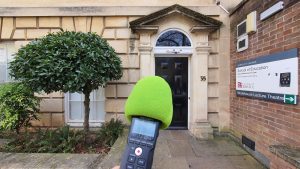Along with planes and the hubbub of restaurants, many of the sounds of school were temporarily silenced during the pandemic lockdown: the energetic high-pitched shouting of primary school playgrounds, the end-of-class bell, the squeak of a teacher’s marker pen on the whiteboard. And there were also silences in schools that were silenced – the particular bookshelf-muffled quality of silence in libraries, and the echoing, chair-drag-punctuated silence of the exam hall. Often unrecorded and on the periphery of conscious awareness, these sounds are a key aural element of the school environment, and may affect us emotionally and cognitively, as do the immersive sonic experiences of a forest or a beach or a videogame, giving us subliminal audio cues and triggers.
While there is some nascent research literature on the role of the aural environment in schools (Hytonen-Ng et al, 2022; Lum & Shehan Campbell, 2007; Shu & Ma, 2019), we felt that the recent lockdown highlighted how fragile and ephemeral these soundscapes are, that they can not just change but disappear almost overnight. Recently we successfully applied for a small grant from the TLC Research Centre to develop a method for gathering recordings of these sounds, using the School of Education building as a testbed. The aim is to trial ways of recording and editing the sounds of a school – involving the school community if possible – and to publish the results as a ~20 minute audio podcast.

In contrast to the verbal language usually attended to in the lectures and seminars that take place in the building, we do not intend to record any identifiable voices. Instead we will focus on the non-verbal sounds, of doors, lifts, shuffling feet, faintly buzzing lights, the silence of the library (and the deeper silence of the bookshelf area), the tolling of the Wills Memorial bell and the songs of the birds of Berkeley Square (including any nightingales!) Nearer the time, once we have ethics approval, we will advertise when and where we will be recording in and around the school, and ways of participating. In the meantime if you have and questions, comments or suggestions of sounds to record, please let us know!
References
Hytonen-Ng, E., Pihlainen, K., Ng, K., & Karna, E. (2022). Sounds of learning: Soundscapes-teacher perceptions of acoustic environments in Finland’s open plan classrooms. Issues in Educational Research, 32(4), 1421-1440.
Lum, C. H., & Shehan Campbell, P. (2007). The sonic surrounds of an elementary school. Journal of Research in Music Education, 55(1), 31-47.
Shu, S., & Ma, H. (2019). Restorative effects of classroom soundscapes on children’s cognitive performance. International journal of environmental research and public health, 16(2), 293.

This looks to be a fascinating project – I look forward to hearing more… and hearing more.